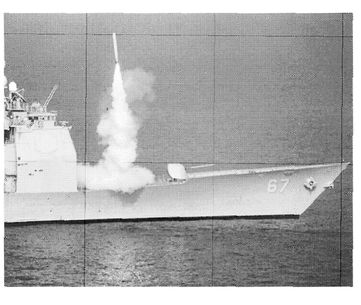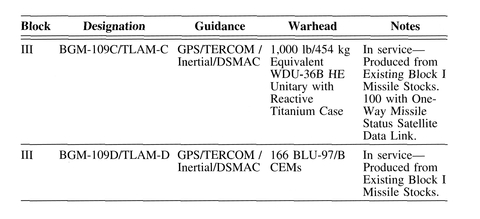Carrier (1999) (39 page)
Authors: Tom - Nf Clancy

A cutaway view of a Raytheon BGM-109 Tomahawk Land Attack Missile.
JACK RYAN ENTERPRISES, LTD., BY LAURA DENINNO
The future of the Seahawk community is looking decidedly upbeat these days, mostly due to the modernization plan that has recently been announced. Shortly, the two hundred or so surviving -B, -F, and -H-model Seahawks will be sent back to the Sikorsky factory in Stratford, Connecticut, to be remanufactured to a common SH-60R standard. All Seahawks will now carry the LAMPS III and -F sensor packages (both sonobuoys and dipping sonar), as well as improved engines and avionics. This upgrade should make it possible for the -R Seahawks to last into the 21 st century until the next generation of sea control helicopter is designed.
Unfortunately, the use of the HH-60H airframes to produce -R-model birds will create a shortfall for the CSAR/special operations force. At the same time, the elderly fleet of UH-46 Sea Knight Vertical Replenishment (VERTREP) helicopters is about to fall out of the sky from wear and tear. Recognizing this, the Navy has ordered the development and production of an entirely new model of Seahawk, the CH-60, which will take over the CSAR/special operations duties previously assigned to the -H model, as well as the VERTREP mission of the Sea Knight. The first prototype is currently flying, and low-rate production has been approved for up to two hundred of the CH-60 variants. First deliveries to the fleet will begin in FY-1999.
Raytheon BGM-109 Tomahawk: The “Other” Strike AircraftNot all the aircraft that fly from the CVBG are manned. Another strike weapon available to battle group commanders for hitting targets ashore is the BGM-109 Tomahawk cruise missile. The Tomahawk is an all-weather submarine- or ship-launched land-attack cruise missile, with a variety of warheads. Stowed in vertical launch tubes or containers, it can be launched from long range, and can strike with pinpoint precision (less than three meters/ten feet from the aimpoint). In the U.S. Fleet, everyone calls it the TLAM (pronounced “tea-lamb”), which is an acronym for Tomahawk Land Attack Missile, to distinguish it from the discontinued TASM, or Tomahawk Anti-Ship Missile. Conceived in the 1970’s for a nuclear “Doomsday” scenario, TLAM has been reborn in the ’90’s as
the
big stick of U.S. policy.
the
big stick of U.S. policy.
TLAM looks rather like a cigar with stubby pop-out wings and tail fins. A solid-fuel booster rocket (which is attached to the rear of the missile and looks like an oversized coffee can) hurls the missile out of its launch canister/ container. TLAM is 18 feet, 3 inches/5.6 meters long (20 feet, 6 inches/6.25 meters with the booster), 20.4 inches/51.8 cm in diameter (it fits inside a standard 21-in/533mm torpedo tube), has a deployed wingspan of 8 feet, 9 inches/2.7 meters, and weighs 2,650 lb/1,192.5 kg (3,200 1b/1,440 kg with the booster). It flies at a speed of approximately Mach .75/550 kn/880 kph, and has a range of 870 nm/1,000 mi/1,610 km for the basic land-attack version. The standard payload for a TLAM is a 1,000-lb/454-kg-class “unitary” warhead that has blast, fragmentary, and penetration effects. There are also versions with other types of warheads, including small submunitions for use on area targets like SAM sites and airfields. TLAMs are not as stealthy as F-117’s or B-2’s, but they are still almost undetectable by an enemy, thanks to the missile’s small radar cross-section and low-altitude flight path.
59
And because the turbofan engine emits very little heat energy, infrared detection is no easier.
59
And because the turbofan engine emits very little heat energy, infrared detection is no easier.
The current TLAM inventory has a complex family tree of variants and modifications, extending through three distinct generations or “Blocks.” These are distinguished mainly by the different guidance and warhead systems shown in the table below:
BGM-109 Tomahawk Variant Chart

The launch of a BGM-109 Tomahawk Land Attack Missile (TLAM) from the Aegis cruiser USS
Shiloh
(CG-67) during Operation Desert Strike in 1996. Cruise missiles like the Tomahawk are frequently integrated with manned airstrikes to help suppress enemy air defenses.
Shiloh
(CG-67) during Operation Desert Strike in 1996. Cruise missiles like the Tomahawk are frequently integrated with manned airstrikes to help suppress enemy air defenses.
OFFICIAL U.S. NAVYPHOTO


The nuclear-armed TLAM-N was taken out of service by a Presidential executive order shortly after the end of the Cold War in 1991. Similarly, the collapse of the Soviet Fleet at the end of that conflict meant that the long-range (greater than 300 nm/555 km) antishipping capabilities of the TASM were no longer required. Following their withdrawal from service, the TLAM-N and TASM airframes were remanufactured into new Block III missiles (the Navy often does this with so-called “legacy” systems). The Block III missiles have been recently given the new BDU-36B penetrating warhead, with a case composed of highly reactive titanium for penetrating a good thickness of reinforced concrete, as well as exceptional incendiary effects. In about a hundred of the Block IIIs, there is also a one-way satellite data link that at various times during the flight sends updates on the missile’s status and position back to the firing units and command centers. The Block III’s precision navigational systems use a combination of guidance modes to give them the same kind of accuracy (less than three meters/ten feet from the aim point) as an LGB.
When a Tomahawk is launched, the Mk. 111 rocket booster fires, thrusting it vertically into the air (after burnout, the booster is discarded). The wings and guidance fins are then deployed and a cover plate is blown off the inlet duct of the tiny Williams International F107-WR-402 turbofan engine. The F107 burns a special high-energy, high-density liquid fuel called JP-8, which gives it more range per gallon than normal JP-5. As soon as the missile has stabilized, it begins to fly a preprogrammed route to its first navigational waypoint just prior to landfall. Once over land, the missile flies along its programmed flight path to the target. Most of the time, the flight path is monitored by an inertial guidance system, which senses the drift from winds and small flight errors. In order to compensate for any “drift” in the inertial system itself, the TLAM utilizes a system called Terrain Contour Mapping (TERCOM) to match the terrain below with data from pre-surveyed strips of land stored in the missile’s computer. Should the flight path deviate from the planned course, it will be corrected, and the missile will continue to the next TERCOM strip.
60
60
When the missile reaches the target area, the precision Digital Scene Matching Area Correlation (DSMAC) system takes control. This utilizes a downward-looking infrared camera with an infrared illumination system (for consistent lighting at night) that matches up features on the ground and makes any necessary corrections to the missile’s flight path. Though the DSMAC system does not actually “home” onto the target, it does provide enough accuracy to fly a TLAM through the goalpost uprights on a football field. In order to improve the existing Inertial/TERCOM/DSMAC guidance package, a GPS receiver has been installed in the new Block III missiles. In the event of a rapidly planned strike, GPS eliminates the need for TERCOM maps; and with GPS, the atomic clocks aboard the satellites provide a precision Time-of-Arrival (TOA) control capability. Using this, the missile’s arrival at the target can be timed to the second. Once the TLAM is over the target area, the missile’s job is to put the payload onto the desired target. It can fly or dive into the impact point (a bunker or building), explode over a “soft” target (such as an aircraft or radar), or spread a load of submunitions over a desired area.
While the existing stockpile of Block II and III TLAMs are capable of doing a fine job, there are plans to make them even better. Admiral Johnson would like to drive the cost of TLAM strike missiles down, and the way to manufacture them more cheaply is to re-engineer the design to take advantage of new structures, materials, and computer/software advances. This proposed TLAM variant is the so-called “Tactical Tomahawk,” which would probably cost around $575,000 a copy. Tactical Tomahawk would be equipped with a two-way satellite data link, which would allow it to be re-targeted in flight. The new TLAM will also be equipped with a camera system, allowing the missiles to conduct their own damage assessments. Expect to see this new variant in the a few years.
One of the prototype/preproduction F/A-18 Super Hornets during a test flight. The Super Hornet will replace early-model F-14 Tomcats in the early 21st century.
BOEING MILITARY SYSTEMS

Once upon a time, the TLAM filled naval aviators with anxieties. They feared that the Tomahawk had “This machine wants your job!” written on the side. But their fears have faded, and today most of them view the TLAM the way a hunter sees his favorite hunting dog—good and faithful beasts that are willing to go places where human beings should not go, and do things that human beings really should not do. Still, naval aviators like to joke that in the next war no more Navy Crosses will be handed out; the cruise missiles will have hit the really difficult targets! Every bomb carries a political message. Today, TLAM is probably America’s most effective bomb-carrying political messenger. The “Gunboat Diplomacy” of the 19th century has become “Tomahawk Diplomacy” in the 20th and 21st.
The Future: Boeing F/A-18E/F Super HornetThe shortcomings of the existing F/A-18 Hornet are well understood, and have long caused Naval aviators to wish for their resolution. Meanwhile, the 1993 retirement of the A-6E/KA-6D fleet and the failure to produce a replacement for it have meant that NAVAIR has been hard pressed to get
any
kind of new aircraft onto U.S. carrier decks. At one point the feeling seemed to be that since the Navy was unable to produce
new
aircraft, perhaps it might be able to field a highly modified one. Back in 1991, the Navy leadership decided to build an upgraded version of the Hornet, which would replace the F-14 and early versions of the F/A-18. This redesigned F/A-18 would (hopefully!) resolve the Hornet’s fuel-fraction problem as well as other shortcomings and provide an interim aircraft until a more advanced and suitable long-term solution to the Navy’s aircraft procurement need could be developed. Thus was born the F/A-18E/F Super Hornet, the key to the Navy’s current naval aviation upgrade plan.
any
kind of new aircraft onto U.S. carrier decks. At one point the feeling seemed to be that since the Navy was unable to produce
new
aircraft, perhaps it might be able to field a highly modified one. Back in 1991, the Navy leadership decided to build an upgraded version of the Hornet, which would replace the F-14 and early versions of the F/A-18. This redesigned F/A-18 would (hopefully!) resolve the Hornet’s fuel-fraction problem as well as other shortcomings and provide an interim aircraft until a more advanced and suitable long-term solution to the Navy’s aircraft procurement need could be developed. Thus was born the F/A-18E/F Super Hornet, the key to the Navy’s current naval aviation upgrade plan.
Other books
Thrill Me by Susan Mallery
Hold Me Closer (Sea Island Brides Book 1) by Kelly, Georgia
Begin to Exit Here by John Welter
They Don't Play Stickball in Milwaukee by Reed Farrel Coleman
Murder Under the Italian Moon by Maria Grazia Swan
My Anchor (Trio Series Book 1) by Blood, Joy
Entwined by Cheryl S. Ntumy
Forget Me Not by Isabel Wolff
ARROGANT PLAYBOY by Renshaw, Winter
Secret in a Suitcase: His Forbidden Desire by JJ Simone